coolant KIA OPTIMA 2020 Features and Functions Guide
[x] Cancel search | Manufacturer: KIA, Model Year: 2020, Model line: OPTIMA, Model: KIA OPTIMA 2020Pages: 591, PDF Size: 14.1 MB
Page 17 of 591

Your vehicle at a glance
62
ENGINE COMPARTMENT
OJFA078152/OJFA078150
■ ■THETA 2.4L - GDI
❈ The actual engine compartment in the vehicle may differ from the illustration.
■ ■THETA 2.0L T-GDI 1. Engine coolant reservoir ...................7-28
2. Engine oil filler cap ...........................7-26
3. Brake fluid reservoir ..........................7-31
4. Air cleaner.........................................7-34
5. Fuse box ...........................................7-60
6. Negative battery terminal..................7-42
7. Positive battery terminal ...................7-42
8. Engine oil dipstick .............................7-26
9. Radiator cap .....................................7-28
10.Windshield washer fluid reservoir ....7-32
JFa PE USA 2.QXP 5/15/2019 3:08 PM Page 6
Page 18 of 591

27
Your vehicle at a glance
OJFA078151
■ ■GAMMA 1.6L T-GDI❈ The actual engine compartment in the vehicle may differ from the illustration. 1. Engine coolant reservoir ...................7-28
2. Engine oil filler cap ...........................7-26
3. Brake fluid reservoir ..........................7-31
4. Air cleaner.........................................7-34
5. Fuse box ...........................................7-60
6. Negative battery terminal..................7-42
7. Positive battery terminal ...................7-42
8. Engine oil dipstick .............................7-26
9. Radiator cap .....................................7-28
10.Windshield washer fluid reservoir ....7-32
JFa PE USA 2.QXP 5/15/2019 3:08 PM Page 7
Page 149 of 591

459
Features of your vehicle
INSTRUMENT CLUSTER
1. Tachometer
2. Speedometer
3. Engine coolant temperature gauge
4. Fuel gauge
5. Warning and indicator lights
6. LCD display
OJFA048100/OJFA048101
■ ■Type A
❈The actual cluster in the vehicle may differ
from the illustration.
For more details, refer to the "Gauges" in
this chapter.
■ ■ Type B
JFa PE USA 4.qxp 5/15/2019 3:19 PM Page 59
Page 152 of 591
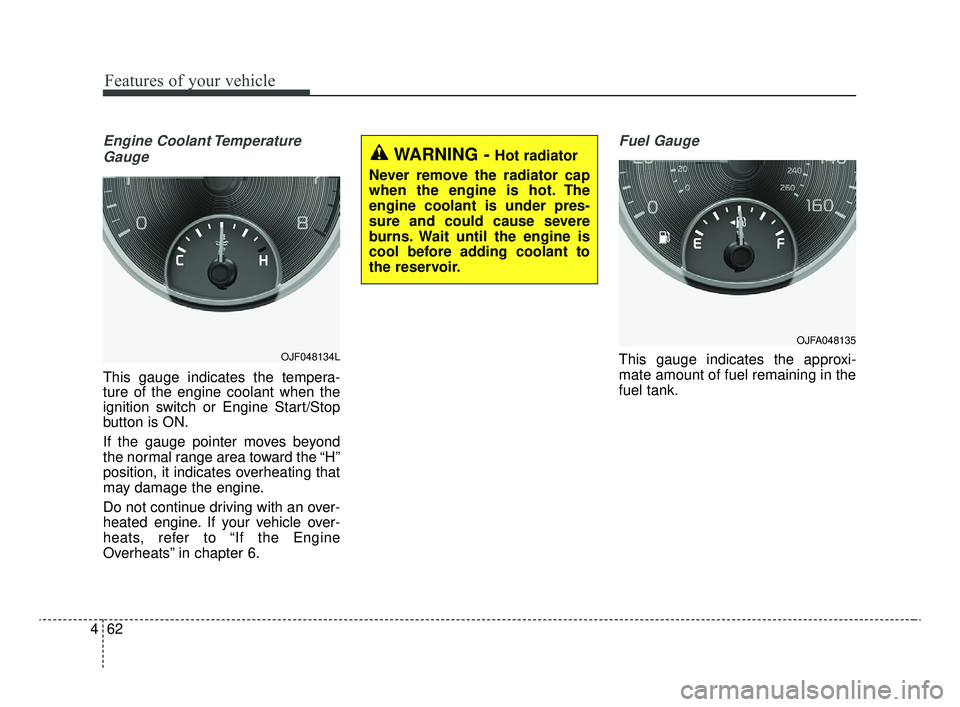
Features of your vehicle
62
4
Engine Coolant Temperature
Gauge
This gauge indicates the tempera-
ture of the engine coolant when the
ignition switch or Engine Start/Stop
button is ON.
If the gauge pointer moves beyond
the normal range area toward the “H”
position, it indicates overheating that
may damage the engine.
Do not continue driving with an over-
heated engine. If your vehicle over-
heats, refer to “If the Engine
Overheats” in chapter 6.
Fuel Gauge
This gauge indicates the approxi-
mate amount of fuel remaining in the
fuel tank.OJF048134L
WARNING - Hot radiator
Never remove the radiator cap
when the engine is hot. The
engine coolant is under pres-
sure and could cause severe
burns. Wait until the engine is
cool before adding coolant to
the reservoir.
OJFA048135
JFa PE USA 4.qxp 5/15/2019 3:19 PM Page 62
Page 258 of 591
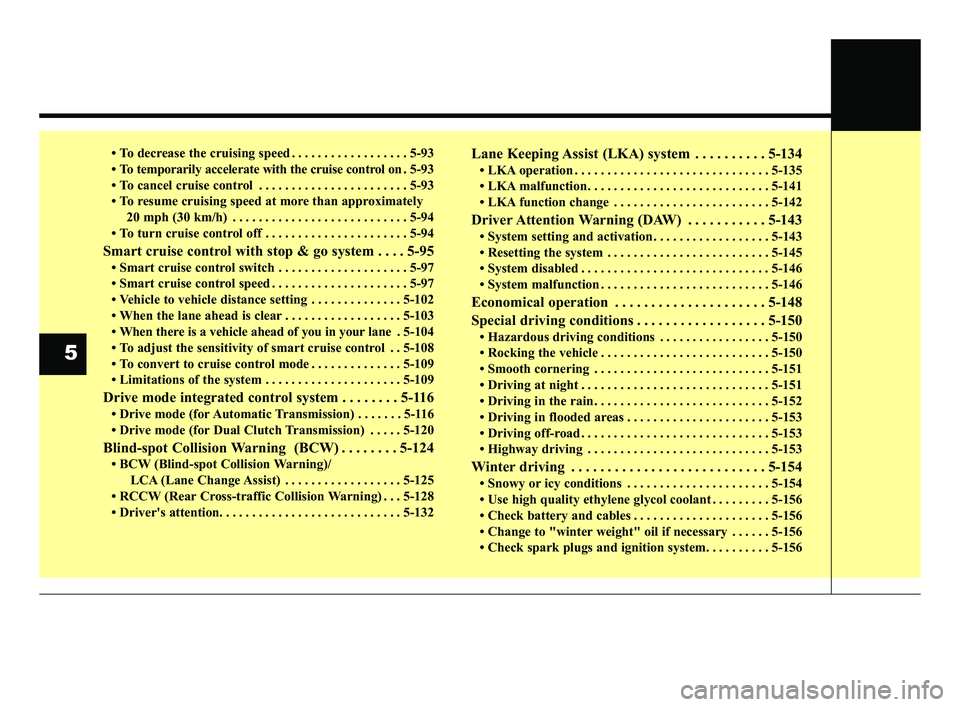
• To decrease the cruising speed . . . . . . . . . . . . . . . . . . 5-93
• To temporarily accelerate with the cruise control on . 5-93
• To cancel cruise control . . . . . . . . . . . . . . . . . . . . . . . 5-93
• To resume cruising speed at more than approximately 20 mph (30 km/h) . . . . . . . . . . . . . . . . . . . . . . . . . . . 5-94
• To turn cruise control off . . . . . . . . . . . . . . . . . . . . . . 5-94
Smart cruise control with stop & go system . . . . 5-95
• Smart cruise control switch . . . . . . . . . . . . . . . . . . . . 5-97
• Smart cruise control speed . . . . . . . . . . . . . . . . . . . . . 5-97
• Vehicle to vehicle distance setting . . . . . . . . . . . . . . 5-102
• When the lane ahead is clear . . . . . . . . . . . . . . . . . . 5-103
• When there is a vehicle ahead of you in yourlane . 5-104
• To adjust the sensitivity of smart cruise control . . 5-108
• To convert to cruise control mode . . . . . . . . . . . . . . 5-109
• Limitations of the system . . . . . . . . . . . . . . . . . . . . . 5-109
Drive mode integrated control system . . . . . . . . 5-116
• Drive mode (for Automatic Transmission) . . . . . . . 5-116
• Drive mode (for Dual Clutch Transmission) . . . . . 5-120
Blind-spot Collision Warning (BCW) . . . . . . . . 5-124
• BCW (Blind-spot Collision Warning)/ LCA (Lane Change Assist) . . . . . . . . . . . . . . . . . . 5-125
• RCCW (Rear Cross-traffic Collision Warning) . . . 5-128
• Driver's attention. . . . . . . . . . . . . . . . . . . . . . . . . . . . 5-132
Lane Keeping Assist (LKA) system . . . . . . . . . . 5-134
• LKA operation . . . . . . . . . . . . . . . . . . . . . . . . . . . . . . 5-135
• LKA malfunction . . . . . . . . . . . . . . . . . . . . . . . . . . . . 5-141
• LKA function change . . . . . . . . . . . . . . . . . . . . . . . . 5-142
Driver Attention Warning (DAW) . . . . . . . . . . . 5-143
• System setting and activation . . . . . . . . . . . . . . . . . . 5-143
• Resetting the system . . . . . . . . . . . . . . . . . . . . . . . . . 5-145
• System disabled . . . . . . . . . . . . . . . . . . . . . . . . . . . . . 5-146
• System malfunction . . . . . . . . . . . . . . . . . . . . . . . . . . 5-146
Economical operation . . . . . . . . . . . . . . . . . . . . . 5-148
Special driving conditions . . . . . . . . . . . . . . . . . . 5-150
• Hazardous driving conditions . . . . . . . . . . . . . . . . . 5-150
• Rocking the vehicle . . . . . . . . . . . . . . . . . . . . . . . . . . 5-150
• Smooth cornering . . . . . . . . . . . . . . . . . . . . . . . . . . . 5-151
• Driving at night . . . . . . . . . . . . . . . . . . . . . . . . . . . . . 5-151
• Driving in the rain . . . . . . . . . . . . . . . . . . . . . . . . . . . 5-152
• Driving in flooded areas . . . . . . . . . . . . . . . . . . . . . . 5-153
• Driving off-road . . . . . . . . . . . . . . . . . . . . . . . . . . . . . 5-153
• Highway driving . . . . . . . . . . . . . . . . . . . . . . . . . . . . 5-153
Winter driving . . . . . . . . . . . . . . . . . . . . . . . . . . . 5-154
• Snowy or icy conditions . . . . . . . . . . . . . . . . . . . . . . 5-154
• Use high quality ethylene glycol coolant . . . . . . . . . 5-156
• Check battery and cables . . . . . . . . . . . . . . . . . . . . . 5-156
• Change to "winter weight" oil if necessary . . . . . . 5-156
• Check spark plugs and ignition system. . . . . . . . . . 5-156
5
JFa PE USA 5.QXP 5/15/2019 3:20 PM Page 2
Page 261 of 591
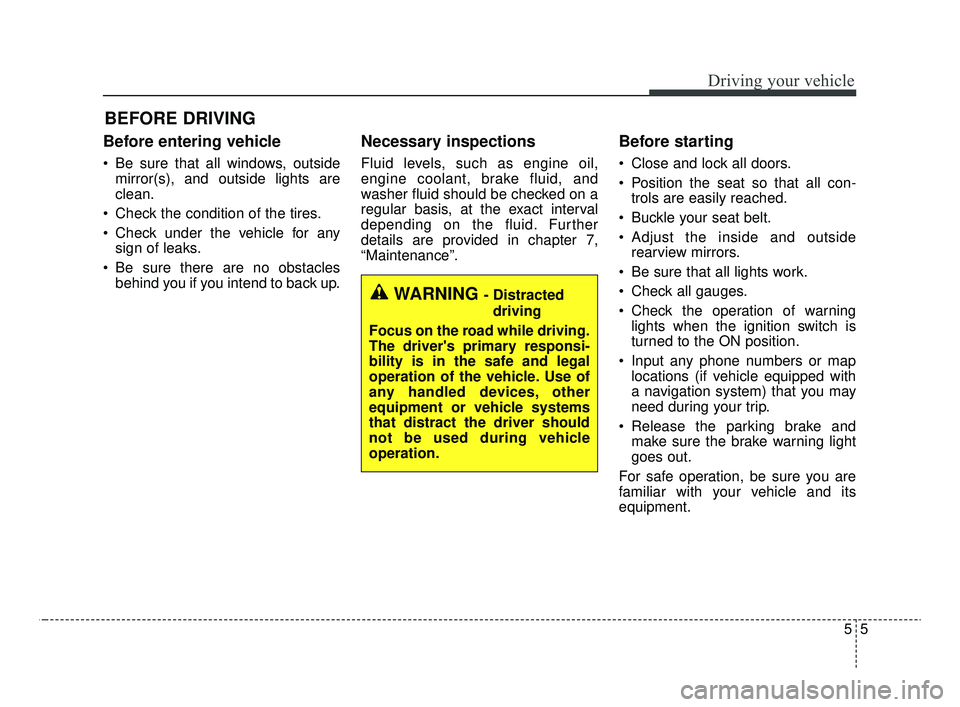
55
Driving your vehicle
Before entering vehicle
• Be sure that all windows, outsidemirror(s), and outside lights are
clean.
Check the condition of the tires.
Check under the vehicle for any sign of leaks.
Be sure there are no obstacles behind you if you intend to back up.
Necessary inspections
Fluid levels, such as engine oil,
engine coolant, brake fluid, and
washer fluid should be checked on a
regular basis, at the exact interval
depending on the fluid. Further
details are provided in chapter 7,
“Maintenance”.
Before starting
Close and lock all doors.
Position the seat so that all con-trols are easily reached.
Buckle your seat belt.
Adjust the inside and outside rearview mirrors.
Be sure that all lights work.
Check all gauges.
Check the operation of warning lights when the ignition switch is
turned to the ON position.
Input any phone numbers or map locations (if vehicle equipped with
a navigation system) that you may
need during your trip.
Release the parking brake and make sure the brake warning light
goes out.
For safe operation, be sure you are
familiar with your vehicle and its
equipment.
BEFORE DRIVING
WARNING - Distracted driving
Focus on the road while driving.
The driver's primary responsi-
bility is in the safe and legal
operation of the vehicle. Use of
any handled devices, other
equipment or vehicle systems
that distract the driver should
not be used during vehicle
operation.
JFa PE USA 5.QXP 5/15/2019 3:20 PM Page 5
Page 376 of 591

Driving your vehicle
120
5
When ECO mode is activated:
The acceleration response may be
slightly reduced if the accelerator
pedal is depressed moderately.
The air conditioner performance may be limited.
The shift pattern of the automatic transmission may change.
The engine noise may get louder.
The above situations are normal
conditions when ECO mode is acti-
vated to improve fuel efficiency. Limitation of ECO mode operation:
If the following conditions occur while
ECO mode is operating, the system
operation is limited even though
there is no change in the ECO indi-
cator.
When the coolant temperature is
low:
The system will be limited until
engine performance becomes nor-
mal.
When driving up a hill: The system will be limited to gain
power when driving uphill because
engine torque is restricted.
When driving the vehicle with the automatic transmission gear shift
lever in manual mode.
The system will be limited accord-
ing to the shift location.Drive mode (for Dual Clutch
Transmission)
SMART mode : SMART modeautomatically adjusts the driving
mode (COMFORT ↔ ECO ↔
SPORT) in accordance with the
driver's driving habits.
COMFORT mode : COMFORT mode provides smooth driving and
comfortable riding. When COM-
FORT mode is selected, it is not
displayed on the cluster.
SPORT mode : SPORT mode pro- vides sporty but firm riding.
JFa PE USA 5.QXP 5/15/2019 3:27 PM Page 120
Page 409 of 591
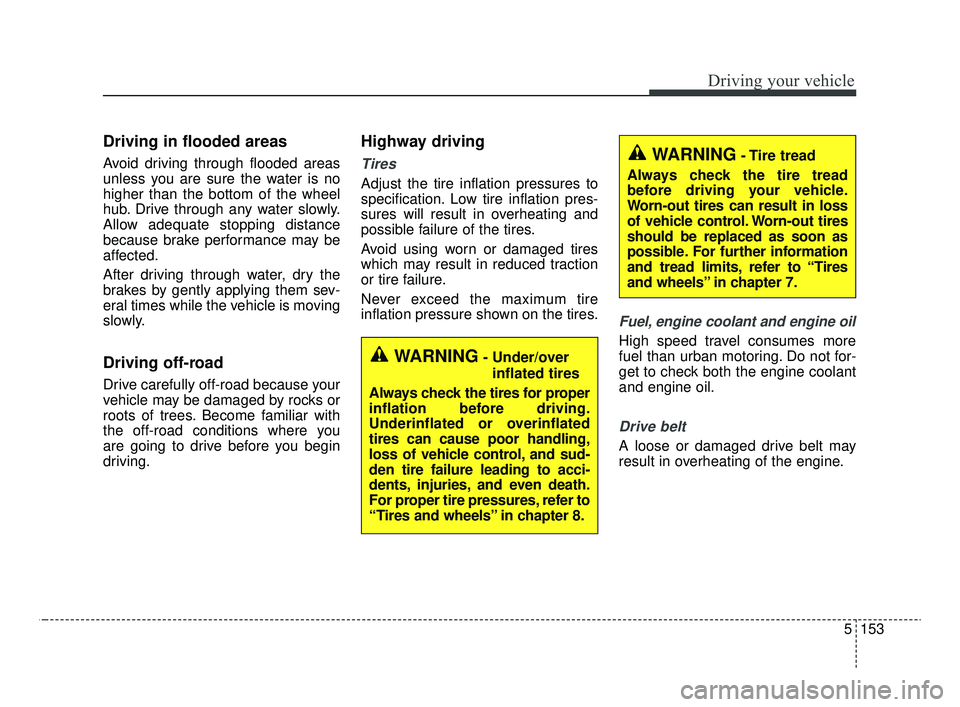
5153
Driving your vehicle
Driving in flooded areas
Avoid driving through flooded areas
unless you are sure the water is no
higher than the bottom of the wheel
hub. Drive through any water slowly.
Allow adequate stopping distance
because brake performance may be
affected.
After driving through water, dry the
brakes by gently applying them sev-
eral times while the vehicle is moving
slowly.
Driving off-road
Drive carefully off-road because your
vehicle may be damaged by rocks or
roots of trees. Become familiar with
the off-road conditions where you
are going to drive before you begin
driving.
Highway driving
Tires
Adjust the tire inflation pressures to
specification. Low tire inflation pres-
sures will result in overheating and
possible failure of the tires.
Avoid using worn or damaged tires
which may result in reduced traction
or tire failure.
Never exceed the maximum tire
inflation pressure shown on the tires.
Fuel, engine coolant and engine oil
High speed travel consumes more
fuel than urban motoring. Do not for-
get to check both the engine coolant
and engine oil.
Drive belt
A loose or damaged drive belt may
result in overheating of the engine.
WARNING- Under/overinflated tires
Always check the tires for proper
inflation before driving.
Underinflated or overinflated
tires can cause poor handling,
loss of vehicle control, and sud-
den tire failure leading to acci-
dents, injuries, and even death.
For proper tire pressures, refer to
“Tires and wheels” in chapter 8.
WARNING- Tire tread
Always check the tire tread
before driving your vehicle.
Worn-out tires can result in loss
of vehicle control. Worn-out tires
should be replaced as soon as
possible. For further information
and tread limits, refer to “Tires
and wheels” in chapter 7.
JFa PE USA 5.QXP 5/15/2019 3:28 PM Page 153
Page 412 of 591
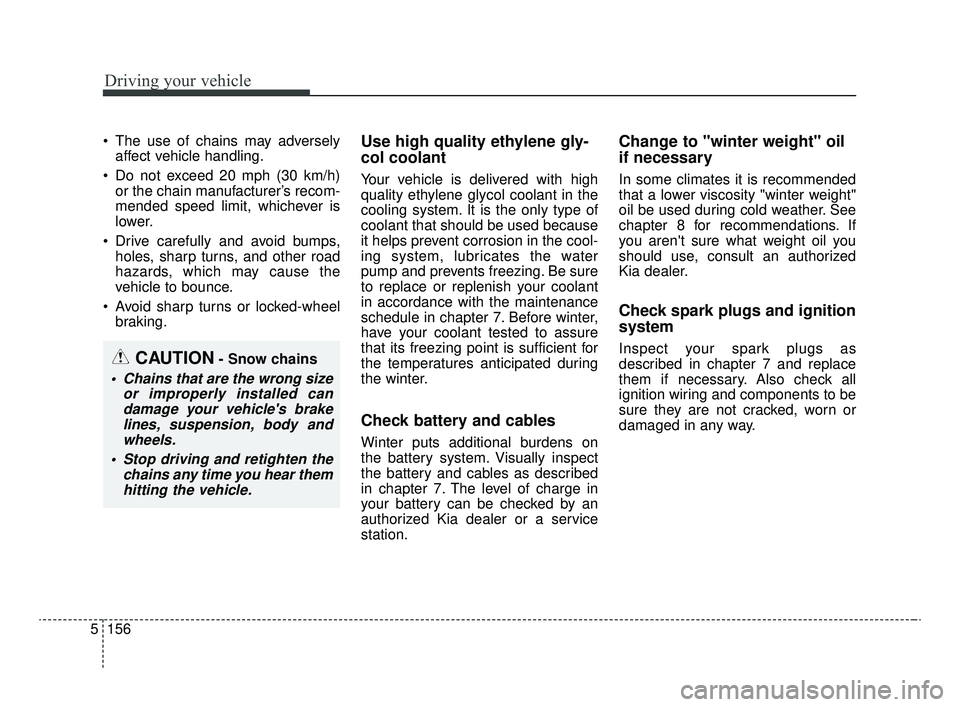
Driving your vehicle
156
5
The use of chains may adversely
affect vehicle handling.
Do not exceed 20 mph (30 km/h) or the chain manufacturer’s recom-
mended speed limit, whichever is
lower.
Drive carefully and avoid bumps, holes, sharp turns, and other road
hazards, which may cause the
vehicle to bounce.
Avoid sharp turns or locked-wheel braking.Use high quality ethylene gly-
col coolant
Your vehicle is delivered with high
quality ethylene glycol coolant in the
cooling system. It is the only type of
coolant that should be used because
it helps prevent corrosion in the cool-
ing system, lubricates the water
pump and prevents freezing. Be sure
to replace or replenish your coolant
in accordance with the maintenance
schedule in chapter 7. Before winter,
have your coolant tested to assure
that its freezing point is sufficient for
the temperatures anticipated during
the winter.
Check battery and cables
Winter puts additional burdens on
the battery system. Visually inspect
the battery and cables as described
in chapter 7. The level of charge in
your battery can be checked by an
authorized Kia dealer or a service
station.
Change to "winter weight" oil
if necessary
In some climates it is recommended
that a lower viscosity "winter weight"
oil be used during cold weather. See
chapter 8 for recommendations. If
you aren't sure what weight oil you
should use, consult an authorized
Kia dealer.
Check spark plugs and ignition
system
Inspect your spark plugs as
described in chapter 7 and replace
them if necessary. Also check all
ignition wiring and components to be
sure they are not cracked, worn or
damaged in any way.CAUTION- Snow chains
Chains that are the wrong size or improperly installed candamage your vehicle's brakelines, suspension, body andwheels.
Stop driving and retighten the chains any time you hear themhitting the vehicle.
JFa PE USA 5.QXP 5/15/2019 3:28 PM Page 156
Page 413 of 591

5157
Driving your vehicle
To keep locks from freezing
To keep the locks from freezing,
squirt an approved de-icer fluid or
glycerine into the key opening. If a
lock is covered with ice, squirt it with
an approved de-icing fluid to remove
the ice. If the lock is frozen internally,
you may be able to thaw it out by
using a heated key. Handle the heat-
ed key with care to avoid injury.
Use approved window washer
anti-freeze in system
To keep the water in the window
washer system from freezing, add an
approved window washer anti-freeze
solution in accordance with instruc-
tions on the container. Window wash-
er anti-freeze is available from an
authorized Kia dealer and most auto
parts outlets. Do not use engine
coolant or other types of anti-freeze
as these may damage the paint fin-
ish.
Don’t let your parking brake
freeze
Under some conditions your parking
brake can freeze in the engaged
position. This is most likely to happen
when there is an accumulation of
snow or ice around or near the rear
brakes or if the brakes are wet. If
there is a risk the parking brake may
freeze, apply it only temporarily while
you put the gear shift lever in P
(Park, Automatic transmission/Dual
clutch transmission) and block the
rear wheels so the vehicle cannot
roll. Then release the parking brake.
Don't let ice and snow accu-
mulate underneath
Under some conditions, snow and
ice can build up under the fenders
and interfere with the steering. When
driving in severe winter conditions
where this may happen, you should
periodically check underneath the
vehicle to be sure the movement of
the front wheels and the steering
components are not obstructed.
Carry emergency equipment
Depending on the severity of the
weather, you should carry appropri-
ate emergency equipment. Some of
the items you may want to carry
include tow straps or chains, flash-
light, emergency flares, sand, shov-
el, jumper cables, window scraper,
gloves, ground cloth, coveralls, blan-
ket, etc.
TRAILER TOWING
We do not recommend using this
vehicle for trailer towing.
JFa PE USA 5.QXP 5/15/2019 3:28 PM Page 157